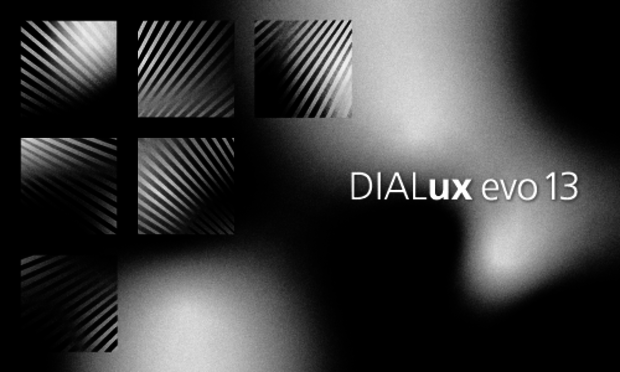Press release, 26/09/2024
DIALux evo 13: Innovations in obtrusive light calculation and BIM integration
Lüdenscheid, [September 26, 2024] – With the release of the new version DIALux evo 13, DIAL GmbH once again sets standards in professional lighting design. The current version offers extensive improvements and new features, particularly in the areas of light immission calculation and BIM integration. The new version can be downloaded from www.dialux.com.
New in DIALux evo 13: Obtrusive light calculation
The focus of the new version is the calculation of light immissions. This powerful new feature allows planners to precisely calculate and evaluate obtrusive light in outdoor areas. With DIALux evo 13, lighting designers and engineers can ensure that lighting installations comply with all relevant standards and regulations for obtrusive light and light immissions. In the first development stage, the following standards are considered:
- CIE150:2017
- EN 12464-2:2014
- LAI:2012
- ÖNORM O 1052:2022
Planners now have access to a new light scene in DIALux for calculating obtrusive light, which automatically considers a maintenance factor of 1 and allows all outdoor luminaires to be added with a single click. With a new tool, planners can place calculation objects for obtrusive light assessment and determine the following values: I (light intensity), ks (glare value), as well as the light flux ratios Ruf, Rul, RULO, and RDLO. A checklist helps the planner verify if all necessary steps for an obtrusive light calculation have been implemented. The glare value (ks) can be visualized as isolines, false colors, or value diagrams, allowing for intuitive analysis in complex scenes. DIALux evo 13 provides new output layouts for documenting the results of an obtrusive light calculation.
Improved BIM integration and enhanced IFC import
DIALux evo 13 has fundamentally improved the import of IFC models (Industry Foundation Classes). A new import method reduces processing time and increases stability when handling complex models, especially for multi-story buildings or detailed projects. As a result, planners can now import IFC data much faster, and the success rate of imports, particularly for complex models, has been significantly increased.
Another significant improvement concerns the adoption of spaces from the IFC model. DIALux evo 13 now imports spaces exactly as defined in the IFC model, including their designations and detailed descriptions. The handling of spaces is now much more flexible; they can be geometrically modified, and their position is independent of the physical room. When exporting the partial model as IFC, DIALux assigns the placed luminaires to the corresponding space, allowing the lighting system to be correctly incorporated into the building model.
Real-time data exchange with Graphisoft DDScad
In cooperation with Graphisoft, DIAL has developed a data interface based on IFC that enables the exchange of information between DDScad and DIALux. When both applications are installed and running on the same workstation, IFC model data can be exchanged in real-time, and changes are automatically synchronized. To use this interface, the planner needs an installation of DIALux evo 13 and the latest version of Graphisoft DDScad, which will be available soon.
Data import for Metaroom 3D models
In collaboration with Amrax, DIAL has developed an interface that allows 3D room models from Metaroom to be imported directly into DIALux. Lighting and electrical planners can accurately capture rooms and buildings with Metaroom and immediately begin lighting design, significantly accelerating and simplifying the planning process. The time-consuming manual construction of room geometry before actual lighting planning is eliminated, representing a significant efficiency gain.
With the combination of Metaroom and DIALux, planners can now test various lighting options in precise 3D models of existing structures to find cost-efficient, aesthetically pleasing, and sustainable solutions. The planning results can then be exported as an IFC model for the Open BIM process or other BIM/AEC applications.
Now available: DIALux evo 13
DIALux evo 13 offers a range of new features that make the lighting design process more efficient, precise, and easier. The software is available as a free version and supports lighting designers and engineers worldwide in planning standard-compliant, aesthetically pleasing, and sustainable lighting.
For more information, visit www.dialux.com
Images

Description
DIALux evo 13 offers a range of new features that make the lighting design process more efficient, precise, and easier.
Open image →

Description
The ks proportonaliy factor can now be represented using isolines, false colours, or value charts, offering multiple visualization methods for assessing obtrusive light in complex scenes.
Open image →

Description
Users can now choose between two import methods for IFC models.
Open image →

Description
DIALux evo 13 now imports spaces exactly as defined in the IFC model.
Open image →

Description
In collaboration with Amrax, DIAL has developed an interface that allows 3D room models from Metaroom to be imported directly into DIALux.
Open image →

Description
In cooperation with Graphisoft, DIAL has developed a data interface based on IFC that enables the real-time exchange of information between DDScad and DIALux.
Open image →